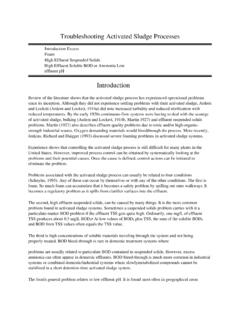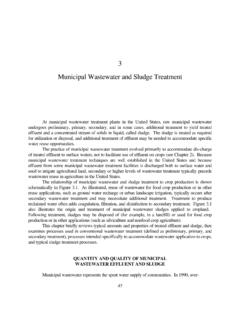Transcription of SLUDGE DEWATERING - SNF Holding Company
1 SLUDGEDEWATERING2 INDEXS ludge characterisation: .. of the SLUDGE : .. different types of SLUDGE : .. SLUDGE : .. SLUDGE : .. SLUDGE : .. SLUDGE : .. SLUDGE : .. SLUDGE : .. that influence the DEWATERING abilities of SLUDGE : .. (g /l): .. organic matter content (%): .. colloidal nature of the SLUDGE : ..61 DEWATERING aids: .. chemicals: .. salts: .. : .. chemicals: .. mechanism: .. particles: .. of the organic chemicals that will influence DEWATERING : .. type of charge ( + or - ): .. charge density (%): .. molecular weight (MW): .. molecular structure: .. type of monomer: ..102 Dynamic thickening.
2 : .. flotation: .. flotation: .. conditioning before flotation: .. table: .. principle: .. conditioning before thickening table: .. drum, screw drum: .. principle: .. conditioning before thickening drum: .. : .. principle: .. conditioning before centrifuge: ..153indexToday, the treatment of water is a well-known process and is executed by state of the art techniques. The SLUDGE resulting from this process represents the next challenge for the water treatment industry, inparticular the minimizing of its SLUDGE DEWATERING handbook will present the key parameters to take into account in order to optimi-ze SLUDGE treatment with SNF Floerger s organic filter DEWATERING .
3 Description and operating principle: .. tests: .. : .. equipment: .. procedures: .. to check and analysis of the results: .. trials: .. up a trial: .. to follow and analysis of results: .. belt filters: .. drainage: .. creeping: .. cake dryness: .. of the adjustable parameters: ..21 Centrifuge DEWATERING : .. description and operating principle: .. tests: .. : .. equipment: .. procedures: .. to check and analysis of the results: .. trials: .. up a trial: .. to follow and analysis of results: .. centrifuges: .. centrate: .. , foaming centrate: .. cake dryness: .. of the adjustable parameters.
4 275 Frame filter press DEWATERING : .. description and operating principle: .. tests: .. : .. equipment: .. procedures: .. to check and analysis of the results: .. trials: .. up a trial: .. to follow and analysis of results: .. frame filter press: .. cakes: .. plugging: .. efficiency loss: ..336index414 SLUDGE Origin of the SLUDGE :During the course of the water treatment, products coming from the pollution are extractedwhile the treated water is released in the these products coming from the pollution one can distinguish: Particles that decant naturally or that come from the physico-chemical treatment Excess micro-organisms coming from the dissolved organic matter treatment Mineral matter that is non biodegradableAll these products are suspended in more or less concentrated forms and the resulting liquidis called The different types of SLUDGE : Primary SLUDGE :Primary SLUDGE comes from the settling process.
5 It is therefore made of easily decantablesuspended particles: large and/or dense has a low level of Volatile Solids content (VSaround 55% to 60%) and its DEWATERING ability is also very easy to concentrate this type of SLUDGE with a static thickening step just befo-re DEWATERING . The drawback is that this SLUDGE ferments very easily. Biological SLUDGE :Biological SLUDGE comes from the biological treatmentof the wastewater. It is made of amixture of microorganisms. These microorganisms, mainly bacteria, amalgamate in bacterial flocsthrough the synthesis of exo-polymers. A simple decantation in the clarifierwill easily separate the bacterial flocs from the treated part of this settled SLUDGE is sent to DEWATERING : the excess biological SLUDGE .
6 Part of itis recirculated to maintain the bacterial population in the are several types of SLUDGE that have specific characteristics that will influence: The choice in conditioning chemical (cationic flocculant, ferric chloride, ) The choice in the DEWATERING equipment to be used (filtration, ) These choices will also depend on the final use of the SLUDGE (incineration, agricultural ) SLUDGE characterisation5To simplify, we will not differentiate between the different qualities of biological SLUDGE (pro-longed aeration, low charge, high ); their main properties are: A high Volatile Solids content: VSaround 70% to 80%. A low dry solids content: 7 g/l to 10 g/l.
7 It is often necessary to introduce a dynamic thickening step by flotation or gravity belt. The DEWATERING ability is medium. It depends partially on the VS. The higher the VS the harder it is to extract the water from the SLUDGE . Mixed SLUDGE :Mixed SLUDGE is a blend of primary and biological sludges. The blending ratio is often asfollows: 35% to 45% of primary SLUDGE . 65% to 55% of biological blending will permit an easier DEWATERING as the intrinsic properties of this SLUDGE arebetween the other two types. Digested SLUDGE :Digested SLUDGE comes from a biological stabilizingstep in the process called digestion.
8 Thisstabilization is performed on biological or mixed SLUDGE . It can be done under different temperatures (mesophilic or thermophilic) and with or without the presence of oxygen (aero-bic or anaerobic). Following this stabilization step the properties of the SLUDGE are: A lower Volatile Solids content: VSaround 50%. A mineralisation of the SLUDGE occursduring digestion A dry solids content around 20 g/l to 40 g/l A good DEWATERING ability. Physico-chemical SLUDGE :This type of SLUDGE is the result of a physico-chemical treatment of the wastewater(seebrochure Coagulation Flocculation ). It is composed of flocs produced by the chemical treat-ment (coagulants and/or flocculants).
9 The characteristics of this SLUDGE is the direct result of the chemicals used (mineral or organiccoagulants) and of course of the pollutants in the water. Mineral SLUDGE :This name is given to SLUDGE produced during mineral processessuch as quarries or miningbeneficiation processes . Their nature is essentially mineral particles of various sizes (includingclays). They have a very good aptitude to settle by gravity and very high concentrations arefrequently Parameters that influence the DEWATERING abilities of SLUDGE :Several parameters concerning the SLUDGE will influence its ability to dewater easily. Amongst these, the main ones are: Concentration (g/l):Measured in g/l, the concentration of the SLUDGE will influence: The incorporation of the flocculant.
10 The higher the concentration of the SLUDGE , the harderit is to mix in a viscous solution of flocculant (even at low flocculant concentrations). Solutions to this problem are: post-dilution of the flocculant, injecting the flocculant upstream, multiple injection points of the flocculant, use an on-line mixer. The consumption of flocculant. The higher the concentration of the SLUDGE , the lowerthe consumption of flocculant. This is true only if the incorporation is correctly done. The organic matter content (%):The organic matter content is comparable to the Volatile Solids content (VS).The higher the VS, the more difficult the DEWATERING .








